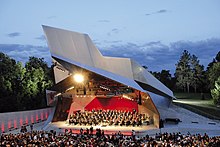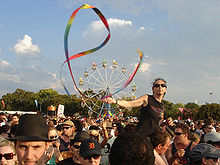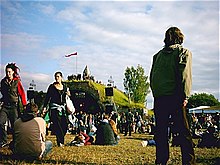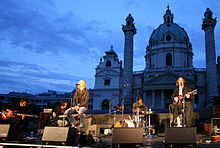Open air concert
An open-air concert , also open-air concert ( english open-air , outdoor ') is held each outdoor concert . As a rule, modern music such as pop or rock music is played at an open-air concert, which - depending on the event - may cost admission to attend. But concerts with classical music are also being played outdoors more and more often. If several such concerts (usually over several days) take place at the same location, this open-air concert is also known as a music festival or an open-air festival .
history
Open-air concerts have been organized and noticed by a broader public since the late 19th century. Since 1894, so-called promenade concerts on the Embankment have been held on London's Thames in the summer , usually around noon. In contrast to normal concerts in halls or opera houses, the audience was mostly men who came out of their offices, or newspaper boys who stopped and listened. A music critic for the Times saw the promenade concerts as a sophisticated contrast to the " Easy Listening " concerts in London's parks, which one only listened to on the side. Even long works such as Franz Schubert's Symphony in C major cast a spell over the people in the Victoria Embankment Gardens and, despite the significantly poorer acoustics, have an effect that is not known from concert halls.
In the absence of electrical amplification, the conductors chose a different composition of instruments for the open-air concerts. In particular, you need fewer strings outside. This, according to the critic, dictated silence like no other instrument. Incidentally, at the promenade concert you learn from experiences in military music , where, for example, clarinets take over the string parts in order to play yourself forward.
technology

The stage or festival stage of an open-air concert is usually a construction made up of trusses, which is usually erected around 1 to 3 days before the concert.
To protect the electronic equipment ( light and sound system) from rain, the stage is in most cases provided with a roof. However, there are also smaller open-air stages that can be transported as a whole on a single truck. Its construction is carried out in such a way that the truck trailer is brought into the correct position and then the stage floor is "unfolded" and the roof is raised hydraulically. The scaffolding for the headlights (“ traverse ”) is hung in this. The same or similar lighting effects as in discos are usually installed on rigs . The loudspeakers of the public address system are usually hung or stacked in towers built up to the left and right of the stage, bass boxes can also be located on the floor below the front edge of the stage or to the side of it. The mixers for light and sound located in large open-air festival in its own tower in front of the stage ( front of house ) and with the stage equipment ( backline ) via a stage box connected. Movable pursuit lights can also be housed either in the FOH tower or in their own trusses.
In large areas, additional towers with loudspeakers (so-called "delay towers" / " line arrays ") or with video screens from "stage hands " are often built in the public area to improve acoustics .
Open-air stages, like other temporary temporary structures, must be approved from a certain size. In the event of negligence, storms or panic, festival visitors also have an increased risk of accidents, such as at the Pukkelpop Festival 2011. Because of the high volume of the music, open-air concerts that last late into the night can usually only take place in areas away from inhabited houses.
Open-air discos have certain similarities with open-air concerts, which can also be housed in buildings with a hinged roof such as the “Mega-Drome” in Radebeul . In contrast to an open-air concert, there is usually no live music here.
Multi-day open-air events
Admission controls at commercial open-air concerts and festivals are quite strict; The safety regulations usually provide that z. B. no objects considered as weapons or often no pointed objects such as umbrellas (danger in a crowd) may be taken. Rather for economic reasons, z. B. no own drinks are brought onto the premises. You will find a large number of stands there, with often only the sponsor's beer being served. There is also a large selection of restaurants (kebab and pizza). You can also find increasingly larger non-food areas where, in addition to the sale of merchandising items from the artists performing at the festival, there is also a promising range of leisure items (water pipes, jewelry, etc.). Larger events sometimes offer a range of leisure activities, e.g. B. Bungee jumping . The reason for the wide range of commercial offerings in addition to music is the additional source of income from bar and booth fees, which is why some organizers, for example, take very rigid action against black marketeers. The income from this area often exceeds the income from the sale of tickets many times over.
After the actual festival appearances, which take place until around 1 or 2 a.m., many pop and rock events take place in large tents, some of which last until the early morning.
At the larger commercial festivals (such as Rock am Ring and Hurricane ), the actual festival area is usually separated from a campsite. Every paying festival-goer can be identified by a fabric or plastic bracelet that is attached to the wrist when the ticket is handed in and loses its validity upon acceptance.
camping
The reason for going to a music festival is not necessarily just the bands performing, but can also be the event itself. This experience is strongly linked to camping , which is offered at most festivals and can sometimes be used several days before the start of the music program. Festival visitors differ in many ways from usual holiday campers. As a rule, festival visitors are young people who want to spend a few days together in larger groups. Often several tents are set up in a circle around a central square. This is designed extremely individually by the festival visitors with flags, music systems or instruments and awnings.
In the early days of open-air festivals, an increasing number of spectators who only took advantage of the camping facilities turned out to be a financial problem for the organizers. To prevent this, at commercial festivals today, only ticket holders can use the camping site. In addition, there have also been attempts to regulate the number of food brought along and e.g. B. Carry out controls when entering the camping area to allow only small amounts of alcohol.
Well-known festivals

Germany
- With Full Force ( Leipzig )
- Parookaville ( Weeze )
- Airbeat One ( Neustadt-Glewe )
- Bang Your Head ( Balingen )
- Rhine culture ( Bonn )
- Film nights on the banks of the Elbe ( Dresden )
- Open Flair ( Eschwege )
- Rock Hard Festival ( Gelsenkirchen )
- Stadtpark Open Air ( Hamburg )
- The festival ( Karlsruhe )
- Metalfest ( Loreley )
- Topless ( Munich )
- Southside ( Neuhausen ob Eck )
- Rock im Park ( Nuremberg )
- Rock am Ring ( Nürburgring )
- Rocco del Schlacko ( Püttlingen-Köllerbach )
- Nature One ( formerly Pydna rocket base , Hunsrück )
- Hurricane Festival ( Eichenring , Scheeßel )
- HipHop Open ( Stuttgart )
- Wacken Open Air ( Wacken )
- World Music Festival Horizonte ( Koblenz )
- Summer Breeze ( Dinkelsbühl )
- Rhön Rock Open Air ( Hünfeld )
Austria
- Picture on festival ( Bildein )
- Bregenz Festival ( Bregenz )
- Clam Concerts ( Burg Clam )
- Grafenegg Music Festival ( Grafenegg )
- New Orleans Festival ( Innsbruck )
- Seewiesen Festival ( Kleinreifling )
- Linz Sound Cloud ( Linz )
- Open air scene ( Lustenau )
- Nova Rock ( Nickelsdorf )
- Jazz & The City ( Salzburg )
- Music Festival Steyr ( Lamberg Castle )
- Opera Festival St. Margarethen ( Roman quarry St. Margarethen )
- Frequency ( St. Pölten )
- Urban Art Forms Festival ( Unterpremstätten )
- Jazz over Villach ( Villach )
- Austrian Brass Music Festival ( Vienna )
- Danube Island Festival ( Vienna )
- Popfest ( Karlsplatz (Vienna) )
- Concert for Europe / Summer Night Concert in Schönbrunn Palace Park ( Vienna )
- Lovely Days ( meadows )
- Two Days a Week ( meadows )
Switzerland
- Gurten Festival ( Bern )
- Openair Frauenfeld ( Frauenfeld )
- Open Air Gampel ( Gampel )
- Greenfield Festival ( Interlaken )
- Montreux Jazz Festival ( Montreux )
- OpenAir St. Gallen ( St. Gallen )
- Zurich OpenAir (Zurich / Glattbrugg)
See also
Web links
- Jürgen Kleindienst: From Highfield to Wacken: These corporations set the pace for German music festivals - who is behind Highfield, behind SMS, Splash, Full Force, Wacken, Melt, Wacken or Rock am Ring? It is no longer the impresarios of the old school who are in charge of the concert and festival business, but large corporations, says the author and organizer Berthold Seliger. That has consequences for cultural diversity - and ticket prices. Leipziger Volkszeitung , online portal, August 22, 2019. Retrieved August 25, 2019 .
Individual evidence
- ^ Symphonies in the Open Air. In: Times. August 13, 1910, p. 11.
- ↑ Pukkelpop Festival in Hasselt: Severe weather kills five. In: Aachener Zeitung. August 19, 2011.



